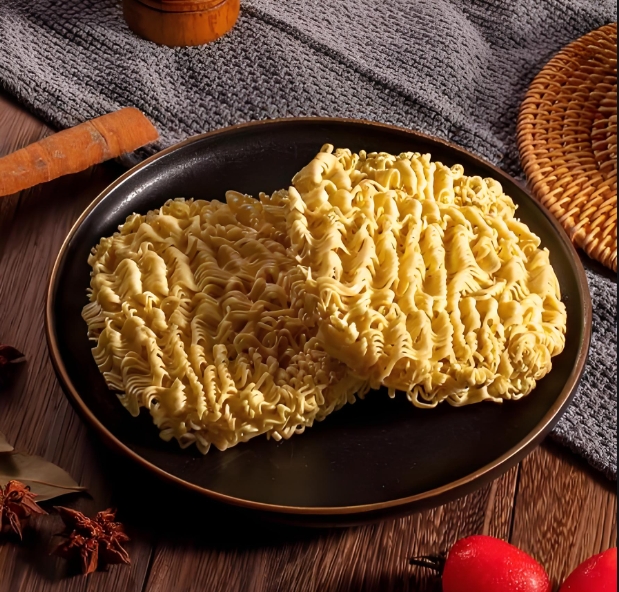Formulation d'une recette de production pour les nouilles instantanées en portion individuelle
The market for single-serve, small-pack instant noodles is vast, encompassing students, office workers, and quick snack enthusiasts. Creating a successful product requires a careful balance of science, culinary art, and food technology. This article outlines the key components and steps in formulating a production recipe for small-pack instant noodles.
1. The Noodle Cake: Structure and Texture
The foundation of any instant noodle is the noodle cake itself. Its quality determines the final texture—whether firm, soft, chewy, or crispy.
Key Ingredients & Ratios (for a ~80g cake):
- Wheat Flour (55-65%): Use a high-protein bread flour (around 11-13% protein). This high gluten content provides the necessary strength and chewy texture for the noodles to withstand frying and rehydration.
- Water (30-36%): Hydrates the flour to form gluten. The exact amount is critical; too little makes dough stiff and difficult to sheet, too much makes it sticky.
- Tapioca or Potato Starch (5-10%): Added to improve texture, reduce oil uptake during frying, and increase the transparency and smoothness of the cooked noodle.
- Salt (1-2%): Strengthens gluten structure and adds basic flavor.
- Alkaline Agents (Kansui) (0.5-1.5%): A blend of sodium carbonate and potassium carbonate. This is the secret behind the distinct springy, firm texture and yellow color of classic instant noodles. It alters the pH of the dough.
- Guar Gum or Xanthan Gum (0.1-0.3%): Acts as a binder, improves water retention, and provides better rehydration properties.
Noodle Making Process:
- Mixage : Combine all dry ingredients, then gradually add water to form a crumbly dough.
- Resting: Allow the dough to rest for 30-60 minutes to fully hydrate and relax the gluten.
- Sheeting & Compounding: Pass the dough through a series of rollers to sheet it, folding and compounding it between passes to align the gluten network.
- Slitting: The sheeted dough is slit into fine or wavy noodles.
- Cuisson à la vapeur : The strands are steamed (90-100°C for 1-2 minutes) to partially gelatinize the starch, making it edible and ready for drying.
- Frying (Flash Frying): The quickest drying method. Noodles are fried in palm or soybean oil at 140-160°C for 60-90 seconds. This removes moisture, sets the structure, and creates tiny pores for quick rehydration. For a non-fried option, hot air drying can be used, though texture differs.
2. The Seasoning Powder: The Soul of the Noodle
This small packet delivers the primary flavor. A basic savory powder can be formulated as follows:
Sample Chicken Flavor Powder Recipe (per 100g batch):
- Salt (40g) – Base carrier and seasoning.
- Monosodium Glutamate – MSG (15g) – Provides umami and enhances savory notes.
- Sugar (10g) – For balancing and slight sweetness.
- Maltodextrin (20g) – Bulking agent and flavor carrier.
- Chicken Powder (10g) – The core flavor.
- Garlic Powder (2g)
- Onion Powder (2g)
- White Pepper Powder (0.5g)
- Soy Powder (5g) – For depth and color.
- Disodium Inosinate & Guanylate (I+G) (0.5g) – Powerful umami synergists.
Processus : Simply blend all finely powdered ingredients together in a industrial mixer until homogenous.
3. The Seasoning Oil/Fat: Richness and Mouthfeel
A small amount of oil enhances the aroma and creates a richer broth.
Sample Seasoning Oil Recipe:
- Refined Palm Oil or Soybean Oil (95%)
- Garlic Essence Oil (2%)
- Onion Essence Oil (2%)
- Chicken Fat (1%) – For authentic flavor.
- Antioxidant (e.g., TBHQ) – As needed to prevent rancidity.
Processus : Heat the base oil gently and infuse with the flavoring agents, then filter and cool.
4. The Vegetable Packet: Visual Appeal and Texture
Dehydrated vegetables add color, texture, and a perception of freshness and quality.
Common inclusions:
- Dehydrated Green Onions
- Dehydrated Carrots
- Dehydrated Corn
- Flakes of Dehydrated Egg
These are prepared separately through hot air drying and added in small quantities (~2-3g per pack).
5. Assembly and Packaging
The final production step is assembly:
- Weigh and place the fried noodle cake into the bowl or pouch.
- Portion the powder seasoning (typically 6-8g), seasoning oil (2-3g), and vegetable pack into separate sachets or add directly.
- Package everything together in a moisture-proof and air-tight package, often with a nitrogen flush to prevent oxidation and breakage of the noodle cake.
Conclusion: A Balanced Formula
Producing a small-pack instant noodle is a complex process of ingredient functionality and precise ratios. The ideal final product is defined by:
- Noodle Texture: Firm and chewy, rehydrating fully in 3 minutes.
- Flavor: Robust, well-rounded, and savory without being overly salty.
- Aroma: Appealing and appetizing upon adding hot water.
This formula provides a foundational recipe. Large-scale production requires rigorous quality control, safety checks, and often consumer testing to refine the flavor profile to suit specific target markets. Continuous innovation in flavors and healthier profiles (e.g., non-fried, lower sodium) is key to staying competitive.








